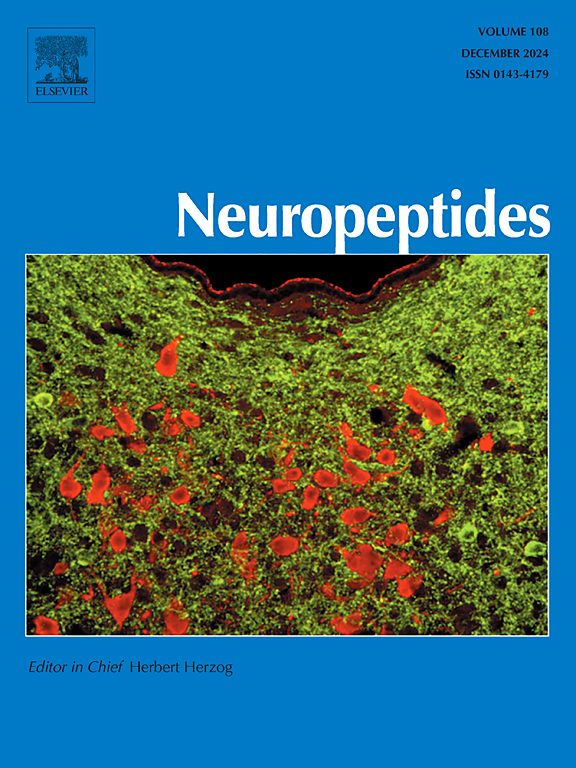Kisspeptin-54 ameliorates chondrocyte senescence in osteoarthritis via SIRT3-mediated telomere protection and p53 acetylation inhibition
IF 2.7
3区 医学
Q3 ENDOCRINOLOGY & METABOLISM
引用次数: 0
Abstract
Background
Osteoarthritis (OA), characterized by chondrocyte senescence and oxidative stress, affects over 300 million people globally. Kisspeptin-54, a neuropeptide with pleiotropic protective effects, was investigated for its role in chondrocyte senescence and its underlying mechanisms.
Methods
Oxidative stress and senescence were induced in primary mouse chondrocytes by treating them with TBHP. Kisspeptin-54 was administered at varying concentrations (10–1000 nM) to assess cytoprotection, while SIRT3 was knocked down using adenoviral shRNA to validate mechanistic pathways. Telomere length, mTERT expression, telomerase activity, and p53 acetylation were evaluated via Southern blot, RT-PCR, and western blot techniques. Furthermore, senescence was evaluated through the application of SA-β-galactosidase staining alongside the measurement of PAI-1 expression.
Results
TBHP induced dose-dependent GPR54 downregulation, oxidative stress (260 % increase in ROS), telomere attrition (41 % reduction in length), and senescence (270 % increase in SA-β-galactosidase-positive cells). Kisspeptin-54 (≤200 nM) rescued cell viability, reduced LDH release (57 % at 200 nM), and mitigated ROS and SOD activity decline. Mechanistically, Kisspeptin-54 restored SIRT3 expression, suppressed p53 acetylation (Acetyl-p53[K382] reduced by 56 % at 200 nM), and preserved telomere function (telomere length restored to 91 % of control). SIRT3 knockdown abrogated these effects, confirming its critical role.
Conclusion
Kisspeptin-54 alleviates chondrocyte senescence via a dual mechanism: (1) SIRT3-mediated restoration of mitochondrial antioxidant capacity and telomere homeostasis; (2) inhibition of p53 hyperacetylation and downstream senescence signaling. These findings establish Kisspeptin-54 as an innovative therapeutic candidate for OA acting through the modulation of the SIRT3/p53 axis to combat oxidative stress and telomere dysfunction.
Kisspeptin-54通过sirt3介导的端粒保护和p53乙酰化抑制改善骨关节炎软骨细胞衰老。
背景:骨关节炎(OA)以软骨细胞衰老和氧化应激为特征,影响全球超过3亿人。Kisspeptin-54是一种具有多效保护作用的神经肽,研究了其在软骨细胞衰老中的作用及其潜在机制。方法:用三必和必肽诱导小鼠原代软骨细胞氧化应激和衰老。Kisspeptin-54以不同浓度(10-1000 nM)施用以评估细胞保护作用,同时使用腺病毒shRNA敲低SIRT3以验证机制途径。端粒长度、mTERT表达、端粒酶活性和p53乙酰化通过Southern blot、RT-PCR和western blot技术进行评估。此外,通过SA-β-半乳糖苷酶染色和测定PAI-1表达来评估衰老。结果:在SA-β-半乳糖苷酶阳性细胞中,thbhp诱导剂量依赖性GPR54下调、氧化应激(ROS增加260%)、端粒磨损(长度减少41%)和衰老(增加270%)。Kisspeptin-54(≤200 nM)挽救细胞活力,降低LDH释放(200 nM时57%),减轻ROS和SOD活性下降。在机制上,Kisspeptin-54恢复了SIRT3的表达,抑制了p53的乙酰化(Acetyl-p53[K382]在200 nM时减少了56%),并保持了端粒功能(端粒长度恢复到对照组的91%)。SIRT3敲除消除了这些影响,证实了它的关键作用。结论:Kisspeptin-54通过双重机制缓解软骨细胞衰老:(1)sirt3介导的线粒体抗氧化能力和端粒稳态的恢复;(2)抑制p53超乙酰化和下游衰老信号。这些发现表明Kisspeptin-54是一种通过调节SIRT3/p53轴来对抗氧化应激和端粒功能障碍的OA的创新治疗候选药物。
本文章由计算机程序翻译,如有差异,请以英文原文为准。
求助全文
约1分钟内获得全文
求助全文
来源期刊

Neuropeptides
医学-内分泌学与代谢
CiteScore
5.40
自引率
6.90%
发文量
55
审稿时长
>12 weeks
期刊介绍:
The aim of Neuropeptides is the rapid publication of original research and review articles, dealing with the structure, distribution, actions and functions of peptides in the central and peripheral nervous systems. The explosion of research activity in this field has led to the identification of numerous naturally occurring endogenous peptides which act as neurotransmitters, neuromodulators, or trophic factors, to mediate nervous system functions. Increasing numbers of non-peptide ligands of neuropeptide receptors have been developed, which act as agonists or antagonists in peptidergic systems.
The journal provides a unique opportunity of integrating the many disciplines involved in all neuropeptide research. The journal publishes articles on all aspects of the neuropeptide field, with particular emphasis on gene regulation of peptide expression, peptide receptor subtypes, transgenic and knockout mice with mutations in genes for neuropeptides and peptide receptors, neuroanatomy, physiology, behaviour, neurotrophic factors, preclinical drug evaluation, clinical studies, and clinical trials.
 求助内容:
求助内容: 应助结果提醒方式:
应助结果提醒方式:


